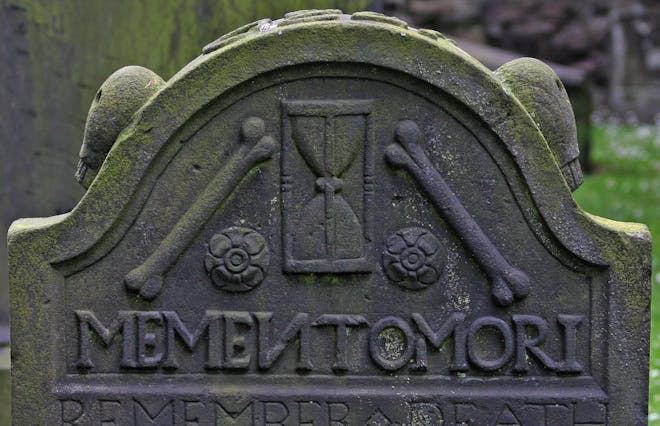What Does Memento Mori Mean?



January 24, 2023
Have you ever seen the phrase memento mori inscribed on a tombstone or as the title of a painting? Did you wonder about the meaning?
20th-century French philosopher Simone Weil sums up the general idea. She says accepting human mortality is crucial to finding purpose in life:
“Belief in immortality is harmful because it is not in our power to conceive of the soul as really incorporeal. So this belief is in fact a belief in the prolongation of life, and it robs death of its purpose.”
― Simone Weil, Gravity and Grace
Plenty of others throughout history agree. Memento more, or “remember death,” is a common theme in philosophy, art, and literature over the centuries. Let’s learn more about this profound phrase and how you can explore your purpose when you take a moment to remember death.
What is the English Translation of Memento Mori?
Memento Mori in History
Memento Mori in Art
Memento Mori Quotes in Literature
What Does Memento Mori Teach Us?
What is the English Translation of Memento Mori?
What is the meaning of the Latin phrase memento mori? Memento mori translates to “remember that you must die” in English. Another memento mori translation is a simple instruction to “remember death.”
Beyond literal translation, the memento mori definition is clear. It is a symbolic or artistic expression that reminds all human beings that death is inevitable.
Sometimes the phrase is combined. Memento mori, memento vivere. This phrase shows a clear juxtaposition that makes the meaning even more apparent. “Remember to die, remember to live.”
Memento Mori in History
Various times, the phrase memento mori was said, or the concept of death was used to focus on life. These instances can help us learn more about its deeper meaning.
From 3100-30 BC, the ancient Egyptians in North Africa believed that after death, the heart was weighed for the final judgment of the dead. On the other side of the scale was the feather of Ma’at, the goddess of justice. If the heart was lighter or equal to the feather, the soul was allowed to enjoy the afterlife. Thus, during life, people were encouraged to remember that death and judgment are at the end of every life.
Plato was an Athenian philosopher who lived in the 4th-3rd century BC in Ancient Greece. As Socrates says in Plato’s Phaedo, “The one aim of those who practice philosophy in the proper manner is to practice for dying and death.” Plato believed that remembering death was vital to understanding eternity and divinity.
In the 9-16th centuries during the Roman Empire, servants would whisper the phrase memento mori in the ear of their victorious general after a triumphant battle was won. As the army marched in procession back to Rome, it communicated glory at cheating death, loyalty, and the upcoming celebration all in one phrase.
Memento mori is also said to have been a phrase used for meditation by Benedictine monks. They would repeat it throughout the day. This Catholic religious order was founded in the 6th century. The order founded autonomous monasteries where followers vowed “stability” and learning. This differed from other religious orders, which focused on strict vows such as silence or hard labor. Benedictine monks commonly become well-known European scholars, historians, and even popes.
Memento Mori in Art
Memento mori art is also a style of artwork carrying the same themes. According to the Tate Modern museum in London, memento mori refers to a piece designed to “remind the audience of their mortality and of the shortness and fragility of human life.”
In this user-generated content titled The Art of Dying, you can get an idea of all types of memento mori art. The curator explains the “classic memento mori composition” contains elements that suggest the temporary nature of human life - a human skull, an hourglass, an unfinished book.
Memento mori art elements often appear in still-life depictions. A still life is a work of art, often a painting, mainly depicting inanimate objects. The objects are shown in a static, non-moving display. Still-life pieces highlight things that eventually die.
Memento mori art elements often include:
clocks, jewelry, hourglasses, or mechanical and time-related contraptions;
natural items such as plants, rocks, food, or fresh-cut flowers (Sunflowers by Vincent Van Gogh);
dead animals or animal skulls (Cow’s Skull with Calico Roses by Georgia O’Keefe);
fruit or wine (Viva la Vida by Frida Kahlo);
books, often unfinished or left open.
Memento Mori Quotes in Literature
Memento mori is a subject matter traditionally popular with both artists and authors. Here are some memento mori quotes:
Everything Fades Away With Time
“Believing the lie that time will heal all wounds is just a nice way of saying that time deadens us.”
― Jonathan Nolan Memento Mori, a 2001 short story appearing in Esquire magazine that was turned into a screenplay for the movie Memento
To Appreciate Life, Face the Reality of Death Daily
“If I had my life to live over again, I would form the habit of nightly composing myself to thoughts of death. I would practice, as it were, the remembrance of death. There is not another practice which so intensifies life. Death, when it approaches, ought not to take one by surprise. It should be part of the full expectancy of life.”
― Muriel Spark, 20th-century Scottish novelist, Memento Mori
What Does Memento Mori Teach Us?
Is memento mori positive or negative? Like the Simone Weil quote from the intro, memento mori art and literature carry a familiar and positive theme. They attempt to show us that acknowledging our immortality gives life a purpose.
Does knowing that our life on earth is limited allow us to use that short time well? Many say yes; memento mori is a concept that comforts and inspires. But how?
What are some ways that you can implement memento mori into your own philosophy?
Explore your religion - As the Benedictine monks did, see what your religious scriptures say about death. Consider praying about what death means for your life. How does your religion provide meaning?
Meditate on your values - You don’t need organized religion to consider what a finite life means to you. What values do you want your life to represent as you meditate on death? What changes might that include? Listen to conversations about death in a podcast to get your ideas flowing.
Make light of death - One way to face death is to make light of it. Consider attending a death festival like Dia de los Muertos. Travel to Mexico or find a nearby Mexican community. Consider talking about death in a death-themed happy hour designed to get people talking about taboo subjects.
Reflect on Death to Make Progress in Life
With its anthropological origins, Latin phrasing, and historical usage, we see that memento mori is a universal human philosophy. It has been used since ancient times to first reflect upon death and then to make progress in life. Whether it is a phrase you meditate on daily or something to journal about once a year, memento mori is a powerful concept that can bring you focus. Interested in connecting with others who have your same focus? Register for an upcoming Reimagine event to explore how you can remember death and reimagine a better life.

